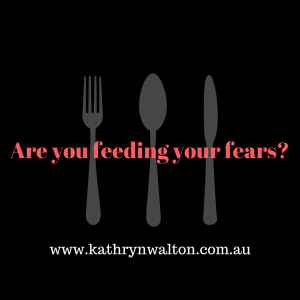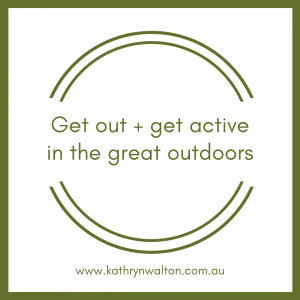
Have you needed to get yourself and your household organised so you can be working or studying from home during the current coronavirus isolation? In this article I share why working from home works well for me (at least at the moment!), the fact that it can take a bit of experimentation to get it right for YOU, and a list of things that I find helpful to work effectively from my home office including systems, tools, routines, and all the other invisible stuff that people often don’t talk about.
Over the last couple of months we’ve seen an unprecedented rise in numbers of people working from home all round the globe. Even though there’s been a gradual transition towards remote work over the past few years, the current wave of moving work to home is absolutely astounding to witness. Getting organised to work from home is just one of many significant changes the world is adapting to during the COVID-19 pandemic.
How are you getting along with it?
I had a love-hate relationship with working from home for a long time
I’m sitting in my home office as I write this blog. At the moment I’m loving it! You see, I’m used to working from home, but that’s not to say I haven’t ever struggled with it! I had a love-hate relationship with working from home for a long time, and I’ve learned what works for me and my family in the space I have. Being self-employed, I’ve pivoted my business a couple of times over the years to better fit my vision, my family and my desired lifestyle. And that means I’ve needed to adapt and re-adapt more than once.
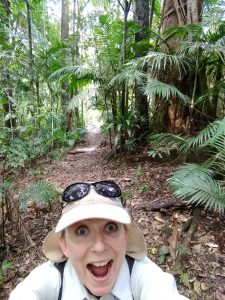
These days a lot of my work can be easily done from home and it saves a lot of money in office rent! My days are mostly spent preparing for workshops, collaborating by email, managing and promoting projects, applying for grants, using video-conferencing and phone for consultations, and of course writing. Not being able to lead bush adventure groups, retreats or workshops, or meet up in person with collaborators at the moment, means I now have space in my day to create my new podcast. This is also easily done from home. All in all, working from home is a really good fit for me.

Getting organised to work from home will take some experimentation
I’m going to share with you a list of things that works for ME with the responsibilities I have and the home environment I’m in. You can use this list to inspire your imagination to make working from home much more do-able for you.
This year, 2020, is the first time in 24 years that I haven’t had school-age children with all the responsibilities that brings. It really has made a huge difference to my work output even though we’re a family of introverts and there isn’t a lot of noise or activity in my neighbourhood! I live out of town on a property in regional Queensland, Australia. YOUR responsibilities, family commitments, home environment, culture, workplace expectations, personality and supports will all have a bearing on how you get organised so you can work from home. It will take some experimentation, practise and negotiation with your employer to optimise how effective and efficient it is!

What does it take to get organised so you can work from home?
Here’s my list of the most important systems, routines and equipment I use to keep myself organised when working from home:
The actual office
- Reliable internet (which only came into being in my region a few short years ago – such a blessing!)
- Computer with webcam
- Printer
- Smart phone
- Stationery (yep – good old notepads, pens, sticky notes, stapler, diary etc)
- Yearly planner
- Desk and chair adjusted for ME to support MY posture
- A quiet space for my office that also provides privacy for calls, video-conferencing and note taking
- Office door that gets closed during confidential discussions or when I need to reduce distractions
- A window to look outside, let the natural light in and let the breeze through
- Resources, books and filing cabinet
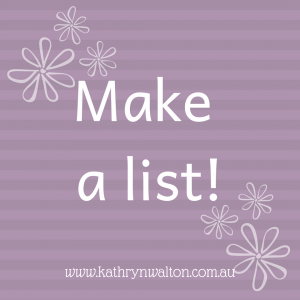
Systems and tools
- “Asana” for project management and daily to-do’s – I love checking off my completed tasks and replicating projects on Asana to save my time. Asana can also be shared in a work team and it syncs beautifully between your devices so it can update in real time.
- “Keep Notes” – I use this for lists and it also syncs between devices
- “Canva” for basic graphic design
- Paper notepad systems – I have separate A4 notepads with different coloured covers for different purposes eg notes from training programs, notes from meetings with collaborators, notes about amazing business ideas that I don’t want to forget
- Alarm – I set a timer for some work tasks and use the alarm for meeting reminders
- Spreadsheets – I still prefer pen and paper but electronic spreadsheets have their advantages. I use them to log my time and budgets on various projects
- Email program – I close it down when I don’t have to have it open because it’s a distraction
- WordPress – mostly easy to edit by myself to keep my website, blog and web shop updated
- Mail Chimp – stores subscriber lists and templates for outgoing emails
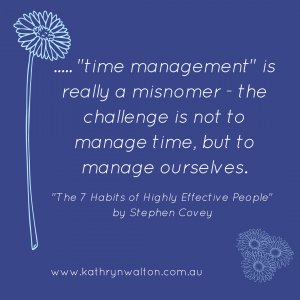
The invisible part of getting organised
- Boundaries – This is probably THE MOST IMPORTANT aspect of getting organised to work from home. Set boundaries or parameters around your availability, work hours, work space, people, emails, phones, meal breaks, toilet breaks, social media, housework, cooking, grocery shopping, everything! If it’s outside your work hours, turn it off. If it’s not being used in the moment, turn it off.
- Distractions – Turn off notifications on anything that really doesn’t matter or that distracts you during work time. Create rules about interruptions and be ready to gently remind others about them. Use self-discipline (see below).
- De-stress your workspace – A cluttered workspace can add to your stress levels. Eliminate what you don’t REALLY need and add some stress-reducing features such as a pot plant, a painting or calming music. Keep your workspace tidy and uncluttered by developing systems to ensure that it doesn’t become a dumping ground for ‘stuff’.
- Places and spaces – Create designated places and spaces for work materials, tools, resources. And then use them rather than spreading everything across the room or the house. Keep it organised – especially anything confidential.
- Legal issues – Check with your employer, insurer, council and landlord about your rights and responsibilities regarding working from home.
- React vs respond – If a new task comes up and it can be done in less than 2 minutes, do it now. Otherwise schedule it.
- Self-care and self-discipline – These go hand in hand. Stick to the task you’re working on and manage distractions. Imagine that your boss, colleague or a video camera is watching (this is not meant to make you feel paranoid!) – what would you be doing differently? Are your actions aligned with your values and intentions?

- Rewards – Reward yourself with a relaxing activity when you’ve achieved your work goals, reached the end of your work hours, or stayed on task. This is a great way of marking the switch between work and personal time.
- Task Lists – Write a list of tasks for each day, categorise them, prioritise them and cross them off when you’ve completed them. Keep your daily to-do list short and keep another list of lesser priority tasks handy that can be brought up as your list gets shorter. I use Asana because I can categorise tasks into different projects and re-prioritise them as needed by sliding them over to the next day or next week. I used to use my diary or notepad or sticky notes – use whatever system works for you.
- Sense of humour – A sense of humour doesn’t go astray – I’m working on that one 🙂
- Family / household support – Talk to your family or housemates, including children, to plan how to meet everyone’s needs through the day (and night). Enlist help and support and work as a team as much as possible. Everyone can contribute to deciding on the priorities and how they will be put into action.
- Systematise your meal times – Plan meals ahead including who’s cooking each night and what time you’ll eat. This also helps optimise your time grocery shopping!
- Batch as many tasks as possible – Using batching techniques for work and personal tasks. I batch my social media design and scheduling as well as my baking which can be frozen and used later.
- Put the big rocks into your day first – Plan the little tasks around the bigger tasks that are less flexible or time consuming. Watch my video on getting organised by putting the big rocks into your day first.
- Time your tasks – Plan your trickiest work tasks for when you feel most alert and when the house is at its quietest.
- Be consistent and clear – Put your work times up on your door, fridge, notice board or anywhere that your family will see it, or maybe an OPEN and CLOSED sign. You can also add work times into your email signature, Google business page and other web-based applications. If you respect your own boundaries, others are more likely to as well.
- Move more, sit less – Get up and move around regularly, at least every 20-30 minutes. It can be tempting to stay working if you’re in flow and everything is quiet but your health and well-being needs you more.
- Delegate jobs around the house – Invest time in teaching others how to do things for themselves. Don’t be a martyr to your work or to the household. This is an opportunity for everyone to learn and develop skills for life rather than another thing to feel guilt about.
- Wear a uniform or work hat – Create a mental and visual boundary between work and personal hours by wearing a uniform, designated work clothes or even a hat that signifies to others as well as yourself which ‘mode’ you are operating in.
- Celebrate – Identify, acknowledge and celebrate when things go well! It’s ever so easy to get caught up in what’s problematic without being present for the little wins and moments of joy along the way.
- Problem-solve – Persist, be patient and get creative when something isn’t working so well. This is an experimental time for many workers and employers. View it as an experiment and explore the challenges and the possible solutions.
- Connect – Create or request opportunities to connect with your work tribe and other supporters regularly by having online or phone meetings, morning teas and brainstorming sessions.
- Think outside the box – Create opportunities to make things work! Working standard office hours may not work when you’re working from home especially if you are also supervising children playing and studying. In fact, it’s unlikely to work! For example, I typically do my internet-heavy tasks (eg watch training videos, upload videos) before 7am because that’s my off-peak internet time. Then I’ll spend a few hours of personal time before getting back to work till late afternoon or evening. I aim to leave my social media tasks till late in the day, use normal business hours for connecting with colleagues, and spend my most energised hours on tasks that need the highest level of concentration.
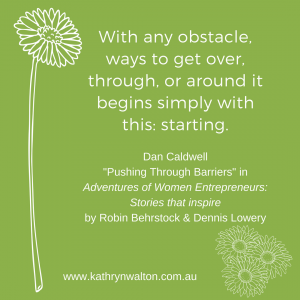
Wow there really are so many aspects of getting organised to work from home when you start to list them all out! This is not an exhaustive list and some of them won’t work for you in your situation. But I do hope it gives you some hope and some ideas to work on for yourself. Let me know how it’s going for you!
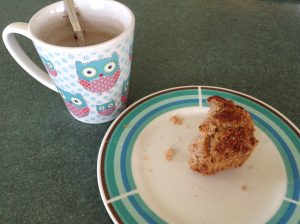
Discovering mountain biking as life’s ultimate parallel universe in her middle age, Kathryn Walton shares information and reflections in ‘Daisy Spoke’ that inform, inspire and empower women to a healthy and active lifestyle.





